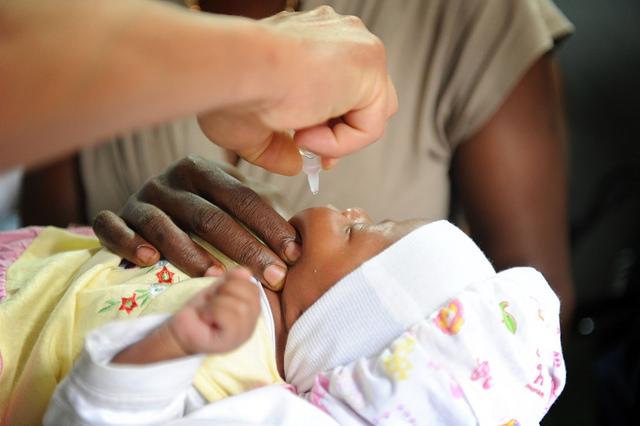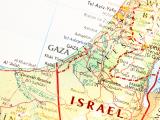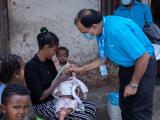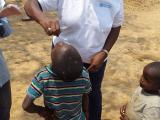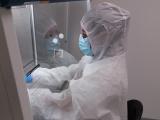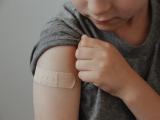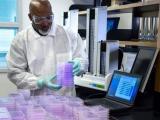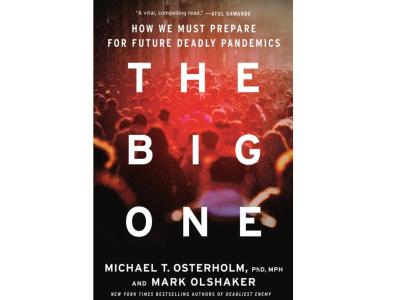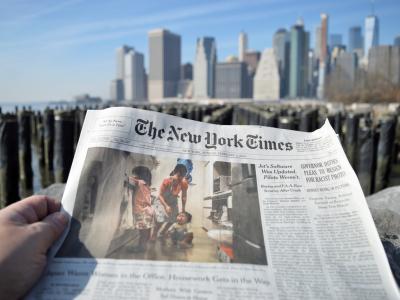The World Health Organization (WHO) today said two separate circulating vaccine-derived polio clusters have been detected in the Democratic Republic of Congo (DRC), as it also revealed new details about a similar outbreak in a conflict-ridden area of Syria.
Health officials there are following up on 3 confirmed cases and 58 cases of acute flaccid paralysis (AFP).
In other polio developments, global health leaders meeting in Atlanta yesterday doubled down on their commitment to eradicating the disease, with $1.2 billion more in funding pledges.
DRC clusters involve 2 types
The events in the DRC involve two separate circulating vaccine-derived poliovirus type 2 (cVDPV2) types, the WHO said in a statement. One type was isolated from two AFP case-patients from two districts in Haut-Lomami province in the south. Their paralysis onsets were Feb 20 and Mar 8. The other was isolated from three people in Maniema province in the country's east central region: two AFP cases with Apr 18 and May 8 paralysis onsets and a healthy community contact.
The DRC's health ministry and its partners have completed a risk assessment, and outbreak response plans are being finalized, which will include strengthened surveillance, active AFP case identification, and supplementary vaccination with monovalent oral polio vaccine type 2 (mOPV2) according to global protocols. The WHO said neighboring countries have beefed up surveillance and immunization activities.
The WHO said the risk of further spread of the strains within the DRC is high and that the threat of international spread is medium.
Lab testing still under way in Syria
After a mid-May report saying that health officials were investigating a cluster of 23 AFP cases in Syria, the WHO and Global Polio Eradication Initiative (GPEI) last week announced that three cases of cVDPV2 had been detected in children in Syria's Deir ez-Zor governorate.
In an update today, the WHO said the virus has been detected in stool specimens of two children with Mar 5 and May 6 paralysis-onset dates, as well as in a contact whose sample was collected on Apr 17.
As of Jun 6, 58 AFP cases have been reported. Tests have ruled out polioviruses for 11 of the cases, and the rest of the samples are still being processed or are on their way to labs for testing, the WHO said.
The Al Mayadeen district outbreak area was also the epicenter of a wild poliovirus type 1 (WPV1) outbreak in 2013, which prompted an aggressive response, with no WPV1 cases reported since January 2014.
Based on the new developments, health officials are pulling together a response plan, which will include supplementary immunization with monovalent oral polio vaccine type 2, in line with global protocols.
Though Deir ez-Zor is an insecure area, the WHO said that since early 2016 the governorate has been partially reached by several vaccination campaigns against polio and other diseases. This year, two campaigns using bivalent oral polio vaccine were conducted in March and April.
The last full trivalent oral poliovirus (tOPV) vaccine rounds took place in October 2015, with tOPV campaigns in the first part of 2016 reaching only part of their targets, the WHO said. It added that in 2008, Syria introduced two doses of inactivated polio vaccine (IPV) to its routine infant immunization schedule.
Authorities are conducting an updated risk analysis, including assessments of overall population immunity and active searching for additional AFP cases, the WHO said. Neighboring countries are also stepping up their surveillance and immunization activities.
The WHO said Syria's risk assessment will need to be completed as soon as possible to guide mOPV2 and IPV vaccination response. "It will be critical to achieve the highest possible coverage during the vaccination response."
"The detection of cVDPV2 underscores the importance of maintaining high levels of routine vaccination coverage at all levels to minimize the risk and consequences of any poliovirus circulation," the WHO said, adding that outbreaks show how insecurity hampers efforts to maintain the high population immunity through routine vaccination.
Donors ramp up funding
Yesterday, global health leaders meeting at a Rotary Convention in Atlanta reaffirmed their commitment to eradicating polio, pledging $1.2 billion to help meet the goal, the United Nations Children's Fund (UNICEF) said in a press release.
The number of countries where the disease is endemic has shrunk to three (Afghanistan, Nigeria, and Pakistan), and the number of cases continued to fall, with only five cases involving wild poliovirus reported so far this year.
Chris Elias, global development president with the Bill and Melinda Gates Foundation, said in the statement that the efforts of Rotarians, government, health workers, partners, and donors have put the world closer than ever to eradicating polio. "These new commitments will help ensure that we will finish the job."
The Gates Foundation announced the extension of a funding match with Rotary, worth a total of $450 million. Other major pledges came from Canada, the European Commission, Japan, the Crown Prince of Abu Dhabi, the Dalio Foundation, Bloomberg Philanthropies, an anonymous donor, Australia, Germany easyJet, Italy, and South Korea.
Anne Schuchat, MD, acting director of the US Centers for Disease Control and Prevention, one of the five partners that has helped spearhead GPEI efforts, said in the statement, "Constant innovation has been key to improving vaccination coverage and reaching more children with the polio vaccine. The unrelenting commitment and support of these global leaders will help us do just that—and ultimately end this disease for everyone and forever."
In a statement today, WHO Director-General-Elect Tedros Adhanom Ghebreyesus, PhD, welcomed the new contributions and pledges for the GPEI. "It is humbling to see again the power of this incredible global partnership to generate funding to fight one of the world's most horrible and debilitating diseases."
He said the new pledges show that donors understand the urgent need to support the goal to the very end. "We must finish the job properly to ensure that there is no chance of this terrible disease coming back."
See also:
Jun 13 WHO statement on polio in the DRC
Jun 13 WHO statement on polio in Syria
Jun 12 UNICEF press release
Jun 13 WHO statement welcoming new polio eradication funding
